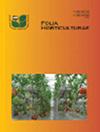Green extraction of bioactive compounds from Azadirachta indica in aqueous glycerol and modelling and optimisation by response surface methodology
IF 2.2
4区 农林科学
Q2 HORTICULTURE
引用次数: 1
Abstract
Abstract Development of efficient and green methods for extracting bioactive phytochemicals has great industrial value. Increasing environmental sensitivity at the global level has tremendously enhanced the demand for such methods. Azadirachta indica is a well-known medicinal tree. As glycerol has emerged as a green and safe extraction solvent for bioactive phytochemicals, this study aimed to investigate the efficacy of a glycerol–water solvent system to extract bioactive compounds from A. indica leaves. Modelling and optimisation were carried out by using response surface methodology (RSM) as per the Box–Behnken design with three variables, namely, solvent concentration, time and temperature. The responses were total phenolic content (TPC), total flavonoid content (TFC), 2,2-diphenyl-1-picrylhydrazyl (DPPH) radical scavenging activity and metal chelating activity (MCA). The optimum conditions found by numerical optimisation were a solvent concentration of 69.713%, a time period of 38.328 min and a temperature of 32.114 °C with the predicted values of TPC, TFC, %DPPH and %MCA as 5.27 mg gallic acid equivalents · g−1 DW (dry weight), 9.869 mg rutin equivalents · g−1 DW, 73.8% and 54.366%, respectively. The validation experiments showed almost the same results for each response with very low% errors (5.431–7.661). Increasing glycerol concentration in the extracting medium favoured the extraction of TPC, TFC and antioxidant phytochemicals, but for MCA, the trend was the opposite. In conclusion, 70% aqueous glycerol is an effective medium for the extraction of polyphenolic and antioxidant phytochemicals from A. indica leaves. Extraction models suggested by RSM have high prospects to be used on a large industrial scale.水溶甘油绿色提取印楝生物活性化合物及响应面法建模与优化
摘要开发高效、绿色的植物活性化学物质提取方法具有重要的工业价值。全球一级对环境日益敏感,极大地增加了对这种方法的需求。印楝是一种著名的药用树木。由于甘油已成为一种绿色、安全的生物活性植物化学物质提取溶剂,本研究旨在研究甘油-水溶剂系统从a.indica叶中提取生物活性化合物的功效。根据Box-Behnken设计,使用响应面方法(RSM)进行建模和优化,其中包含三个变量,即溶剂浓度、时间和温度。反应为总酚含量(TPC)、总黄酮含量(TFC)、2,2-二苯基-1-苦基肼(DPPH)自由基清除活性和金属螯合活性(MCA)。通过数值优化发现的最佳条件是溶剂浓度为69.713%,时间为38.328分钟,温度为32.114°C,TPC、TFC、%DPPH和%MCA的预测值分别为5.27 mg没食子酸当量·g−1 DW(干重)、9.869 mg芦丁当量·g–1 DW、73.8%和54.366%。验证实验显示,每个响应的结果几乎相同,误差百分比非常低(5.431–7.661)。提取介质中甘油浓度的增加有利于TPC、TFC和抗氧化植物化学物质的提取,但对于MCA,趋势相反。总之,70%的甘油水溶液是从籼稻叶片中提取多酚和抗氧化植物化学物质的有效介质。RSM提出的萃取模型具有很高的工业化应用前景。
本文章由计算机程序翻译,如有差异,请以英文原文为准。
求助全文
约1分钟内获得全文
求助全文
来源期刊

Folia Horticulturae
Agricultural and Biological Sciences-Horticulture
CiteScore
3.40
自引率
0.00%
发文量
13
审稿时长
16 weeks
期刊介绍:
Folia Horticulturae is an international, scientific journal published in English. It covers a broad research spectrum of aspects related to horticultural science that are of interest to a wide scientific community and have an impact on progress in both basic and applied research carried out with the use of horticultural crops and their products. The journal’s aim is to disseminate recent findings and serve as a forum for presenting views as well as for discussing important problems and prospects of modern horticulture, particularly in relation to sustainable production of high yield and quality of horticultural products, including their impact on human health.
 求助内容:
求助内容: 应助结果提醒方式:
应助结果提醒方式:


